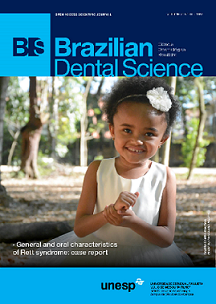Surgical treatment of osteonecrosis associated with bisphosphonates: a case report
DOI:
https://doi.org/10.14295/bds.2017.v20i3.1362Abstract
Bisphosphonates (BP) are routinely used in the management of metastatic bone diseases and malignancies neoplasms, but there is an adverse effect of their chronic use called bisphosphonate-related osteonecrosis of the jaw (BRONJ). Treatment for BRONJ is challenging and complex, as there is still no definitive treatment protocols and the various treatments described in the literature have success variables indexes. In this sense, this study aims to emphasize the responsibility of dentist about the knowledge of BRONJ and report a clinical case that the surgical therapy was the best treatment option. Male patient, sixty-nine years old, asked for dental care complaining about bone exposure. On the anamneses, he reported the use of BP due to cancer history. The intra oral examination revealed exposed bone in the lower right molar region extending to retromolar trigon region on lingual side. There was conservative treatment with antibiotic therapy and mouth rinses of chlorhexidine 0.12 %, but not obtaining success. Therefore, we opted for the surgical removal of necrotic bone area and the tooth involved. The postoperative was within normal standard. The knowledge of dentist about this pathology is essential to prevent, diagnose and treat this disease the most appropriate way. Although the treatment of BRONJ remains challenging and complex, surgical therapy is a treatment option for lesions in early clinical stages and resistant to conservative treatment, providing a better prognosis and quality of life for the patient.
Keywords
Bisphosphonate-associated osteonecrosis; Mandible; Oral surgical procedures.
Downloads
Downloads
Additional Files
Published
How to Cite
Issue
Section
License
Brazilian Dental Science uses the Creative Commons (CC-BY 4.0) license, thus preserving the integrity of articles in an open access environment. The journal allows the author to retain publishing rights without restrictions.
=================




























